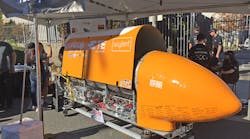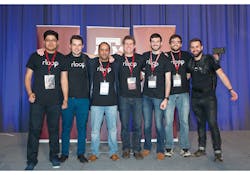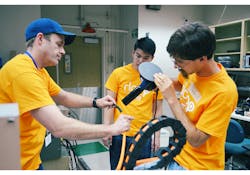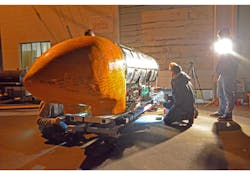Download this article in PDF format.
With all of the hoopla surrounding the Hyperloop, Machine Design wanted to finally sit down and chat with one of the teams in the SpaceX competition. We got a chance to talk with:
Thierry Marin-Martinod, vice president of engineering and chief technical officer of TE Connectivity’s Aerospace, Defense and Marine division, who has sponsored and helped the rLoop team. An electrical system engineer, he has 30 years of professional experience in the aerospace industry, where he has led the development and commercialization of several technical innovations. Marin-Martinod has an aerospace engineering degree from Ecole Superieure des Techniques Aeronautiques et de Constructions Automobiles in France. He has 37 patents, primarily in the aerospace industry.
Brent Lessard, project manager of rLoop. Growing up in Toronto, Canada, Lessard had a very diverse education. He eventually studied Motorcycle Mechanics at Centennial College but wanted something more challenging, so he enrolled in Mechanical Engineering at Durham College. An ardent Star Trek fan, Brent believes in the philosophy and the future espoused by Gene Roddenberry: The acquisition of wealth needs not be the driving force of humanity, but rather working to better oneself and humanity is the greatest motivator. It is this philosophy he brings as Project Manager to rLoop, an open-source and crowdsourced think tank that’s one of the finalists in the SpaceX Hyperloop Competition.
What differentiates rLoop's design from the other competitors?
The rLoop team is decentralized—all of our design and manufacturing was done by a global community of designer and engineers. Focusing on a scalable solution for the Hyperloop didn’t always lend itself to the competition, but if we were devoting the time and resources into this project, we wanted to look at providing viable and scalable solutions. Our design includes:
- Pressure vessel: To accommodate passengers and non-vacuum rated components. Our pressure vessel contains a number of sensors to understand the environment from a passenger’s perspective.
- Active magnetic levitation: To provide levitation, we have an active, as opposed to passive, magnetic levitation system. This allows us to operate independent of the Hyperloop tube and opens up possibilities to integrate with existing infrastructure (i.e., roadways). With these engines, we can hover in place, give the pod omnidirectional control, and provide some thrust, braking, and in-flight control.
- Battery packs: Given that our hover engines require a fair amount of energy, we designed, manufactured, and tested our own battery packs. This on its own was an immense task and accomplishment for the team!
With the efforts of Hyperloop One, Hyperloop Transportation Technologies, and other global entities racing to build the first Hyperloop transportation system, where does rLoop fall in line and how do you see the Hyperloop network unfolding in the next few years?
rLoop has a community of Hyperloop experts who have been immersed in the space for over two years now. We also have functioning hardware including a scalable prototype pod that encapsulates technology necessary for a full-size system. We intend to continue our work, extracting as much data from our prototype pod and employing the knowledge gained in continuing development of our full-scale pod.
We believe the future of technology is owned by the people who make it collectively. We are the first high-tech business that builds communally. For this reason, we’re moving to block-chain technology going forward to coordinate the community.
How did this team form and get sponsorship to compete to be a finalist in the SpaceX Hyperloop competition?
It was a very interesting experience as we started from a thread on the SpaceX subreddit and organically organized into a decentralized team that operates in the cloud. Today, we are over 1,100 members from more than 50 countries working around the clock. We embrace modern collaboration tools to facilitate our work and we are pioneering processes for collaborative virtual design and remote manufacturing. Every step of the way, we are pushing the boundaries of what can be achieved communally.
As far as sponsorship, new tools are coming online every day that give individuals the power to access investment opportunities and support projects that resonate with them. I think it’s a new and exciting space, and the possibilities for it are just beginning to be explored. We found support through TE Connectivity and were even able to raise over $60,000 through crowdsourcing.
How did the transition go from an online thread to something tangible?
That was a challenge for us. We were a virtual team with award-winning designs, but no physical presence, financial backing, or infrastructure to support us. However, we recognized this and prepared for it in advance. By leveraging remote member access to specialty equipment, we could physically manifest in proximity to the competition and we could minimize our physical footprint.
We were lucky to receive support from TE Connectivity to provide us engineering and manufacturing guidance, a place for our makers team to assemble, and work on the prototype. In addition, TE Connectivity gave us access to its specialty tools, sensors, and equipment. We have now built two prototypes completely self-funded and manufactured by an on-site team connected with our virtual and remote designers.
Team members range from teenagers to millennials to retirees. How have these members discovered rLoop? How do you delegate all of the tasks and jobs amongst all of the numerous team members?
The team has largely grown organically. We started and continue to recruit from reddit, but we welcome all with a passion for innovation and who want to have a positive impact on the world. We believe the future of work is open, collaborative, and smart. We have created an organization that accesses the untapped talent within the global workforce. We encourage collaborators to contribute where their interests lie, allowing them mobility within the organization.
Everyone is free to participate among several teams, ranging from public relations and social media to numerical simulation and embedded systems. There is also a free exchange of knowledge among members, which fosters a community of innovation.
As rLoop's mission statement is "radical breakthroughs for the benefit for humanity," after the Hyperloop project, what's next for rLoop?
We believe the processes and organization we have developed over the past several years can be applied to other “moonshot” projects, and we have a database of potential future projects.
What types of adversity does the team face in both day-to-day operations and in gathering the team in Los Angeles?
The team is incredibly passionate and focused on achieving our goals. Being globally distributed presents its challenges such as organizing among wildly differing time zones. We focused on open communication, flexibility in meeting schedules, and thorough documentation.
Assembling the in-person teams was another challenge. For this competition, we had approximately 20 members during test week that were most local to the bay area, but several international members took personal time to come and oversee integration and testing.
What advice could you give our readers if they want to get involved on a collaborative world-changing project?
Find your passion and devote yourself to it. Be open to new and innovative organizational models. Be proactive. Get engaged.
Does rLoop have any involvement or utilize augmented and virtual reality?
We’ve made a VR app to show off some of the components of the pod. We’ve also been developing an AR ground station for some control and monitoring of the pod. In regards to collaboration, we have been developing mixed-reality tools to facilitate communication and cooperation with our on-site makers and our distributed virtual team.
A lot of people put in many hours, money, and resources into this project. Why do you think Elon Musk's Hyperloop concept is viable? Musk describes it as the “5th mode of transportation,” what do you think about it?
Our work so far has shown that, while there are many challenges for the Hyperloop, there are no real show stoppers. We’ve also been focused primarily on vehicle proof-of-technology, but the infrastructure is certainly going to require a fair bit of attention.
What happens if you win the competition? Will you continue to build the Hyperloop system and continue the design?
Our mission is to develop and launch Hyperloop technology. We have a team that’s been immersed in the space for two years now, as well as two prototype vehicles. The competition, for us, is an excellent opportunity to access the SpaceX test facilities, test our pod, and meet with other like-minded and passionate engineers.
So there was some controversy about your non-university team in the last stage of the competition. SpaceX mentioned they are only accepting academic teams and had made an exception for rLoop. This raises the question, should we be encouraging more world-changing science and engineering to be coming from non-academic institutions?
I don’t think the source of potentially world-changing science and engineering should be restricted at all.
You mentioned the passion for this project. What would you say is valued more within rLoop, pushing the boundaries of engineering and science, or just making a drive toward the Hyperloop concept?
Definitely pushing the boundaries of engineering and science. Ultimately, we believe the organization and processes we’ve developed can be applied to other projects that can drive technology forward and have an impact on the world.
You have corporate sponsorships. When it comes to scientific research, there's a lot of speculation on funding that's not government or charitably backed and that nothing can be commercialized or monetized. What do you think science can learn from this idea of sponsorship and backing or using it as a marketing idea?
We were careful about who we partnered with, as we wanted those who shared our values and our vision. The partnership with TE Connectivity was a wonderful fit for us and really was more of a true partnership than a sponsorship. It was an opportunity for us to learn from leading engineers and experts in relevant domains such as cables, connectors, and sensors operating in harsh environments, but also for us to share some of the innovative organizational and collaborative techniques we had developed at rLoop. Actually, TE Connectivity invited us to host a workshop and keynote at its upcoming TECHCON event, under the “Accelerating Collaboration” theme.
While I do think caution needs to be exercised when involving corporate interests with science or engineering, and that more of an emphasis should be placed on open-ended funding of R&D, there is certainly some overlap that can be leveraged to get some real work accomplished.
Why did TE decide to sponsor the rLoop team?
Innovation is one of our core values at TE Connectivity. In fact, we’ve been honored to be named a Top 100 Global Innovator the last five years by Clarivate Analytics. It’s important to us to be at the forefront of new technology and to help engineers transform their ideas into real creations. A crucial aspect of the Hyperloop, like any technology, is the transmission of data, power, and signal.
We felt our technology aligned well with the Hyperloop’s requirements to handle harsh environments, vibrations, speed, temperature, humidity, and more. But beyond just having our products on the pod, our partnership with rLoop fits well with our vision of creating a safer, sustainable, productive, and connected future. The team wasn’t solely focused on winning the competition—they want to create a viable prototype that can be developed at scale to revolutionize how people live, work, play, and learn.
In all honesty, we were more drawn to the team by the way they came together on reddit, how they interacted virtually on platforms like Slack, and their overall passion for the project. There are great stories of rLoop members working a full-time day job and then coming to our facility in Menlo Park to work on the pod till 1 or 2 a.m.—completely voluntarily. It’s easy to want to help create the 5th mode of transportation when you partner with a team comprised of passionate individuals.
What does the sponsorship entail?
Our partnership with rLoop is multi-dimensional. It goes beyond putting our logo on the pod. It’s about coming together to advance innovation and do it in a very unique and non-traditional manner. We, of course, supplied them with the connectors, sensors, wire, and cable to help with the transmission of data, power, and signal.
With the team being virtual, there came a point when they needed to transition to the manufacturing phase. Being the only non-university team in the competition, they didn’t have a home base. We cleared some lab space in our Silicon Valley R&D facility, providing them both shelter and the necessary equipment to manufacture and test the pod. Our engineers also love to be part of these projects, so we set up a group of approximately 30 virtual and on-site TE engineers who volunteered their off-work time to advise and guide the team.
Lastly, we also felt it was important to share the team’s inspirational story with a larger audience. TE.com/rLoop shares information on the technology powering the pod and their virtual working collaboration model. We also produced a five-part documentary webisode series on the team, showcasing their journey to winning a Design Innovation Award from Elon Musk and SpaceX.
What products are on the pod?
We have over 50 different products on the pod, from connectors and sensors to wire and cable. The team worked with our engineers and used TE.com to identify the applicable technology. It’s quite a comprehensive network that is needed to make the pod move at such high speeds while withstanding the demands from the environment.
What is TE learning from the partnership?
Like any partnership, we learn a lot from each other. From new transportation solutions for the future to discovering new ways of working and collaboration tools, we’re refreshing our vision about speed and fast development, challenging some of our existing processes. We are also interested in the mindset of millennial engineers—how they view and solve challenges, their ways of working, and needs for productivity. We’re bringing this passion, innovation, excitement, and speed inside our company.





